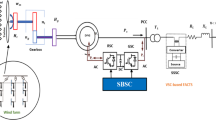Abstract
The nonlinear characteristics of the wind turbines and electric generators necessitate that grid connected wind energy conversion systems (WECS) use nonlinear controls. The present paper proposes an adaptive self tuning control strategy with neural network Morlet wavelet for WECS control. The proposed strategy is based on single layer feedforward neural networks with hidden nodes of adaptive Morlet wavelet functions controller and an infinite impulse response recurrent structure. The neuro controller is based on a certain model structure to approximately identify the system dynamics of WECS, and control its response. The proposed controller is studied in three situations: without noise, with measurement input noise and with disturbance output noise. Finally, the results of the performance of the new controller were compared with a multilayer perceptron network proving a more precise modeling and control of WECS.
Similar content being viewed by others
References
Junhua Y, Jie W, Jinming Y, Ping Y (2004) Apply intelligent control strategy in wind energy conversion system. In: Fifth world congress on intelligent control and automation, WCICA2004. vol 6, pp 5120–5124
Chedid R, Mrad F and Basman M (1999). Inteligent control of a class of wind energy conversion system. IEEE T-EC 14(4): 1597–1604
Kanellos FD and Hatziargyriou ND (2002). A new control scheme for variable speed wind turbine using neural networks. IEEE Power Eng Soc Winter Meeting 1(1): 360–365
Kyoungsoo Ro, Han-ho Choi (2005) Application of neural network controller for maximum power extraction of a grid-connected wind turbine system. Electr Eng (Archiv Elektrotech) 88(1):45–53
Narendra KS and Parthasarathy K (1990). Identification and control of dynmical systems using neural networks. IEEE Trans Neural Netw 1(1): 4–27
Mayosky MA and Cancelo GIE (1999). Direct adaptive control of wind energy conversion systems using gaussian networks. IEEE Trans Neural Netw 10(4): 898–906
Lekutai G and VanLandingham HF (1997). Self-tuning control of nonlinear systems using neural network adaptive frame wavelets. IEEE Int Conf Systems Man Cybern 2: 1017–1022
Sedighizadeh M, Kalantar M (2004) Adaptive PID control of wind energy conversion systems using RASP1 mother wavelet basis function networks. IEEE TENCON 2004, Chiang Mai
Sedighizadeh M, et al. (2005) Nonlinear model identification and control of wind turbine using wavenets. In: Proceedings of the 2005 IEEE conference on control applications, Toronto, pp 1057–1062
Kalantar M, Sedighizadeh M (2004) Adaptive self tuning control of wind energy conversion systems using Morlet mother wavelet basis functions networks. In: 12th Mediterranean IEEE conference on control and automation MED’04, Kusadasi
Szu HH, Telfer BA and Kadambe S (1992). Neural network adaptive wavelets for signal representation and classification. Opt Eng 31(9): 1907–1916
Sedighizadeh M (2005) Modeling and adaptive-neural control of wind energy conversion systems using wavelet functions. PhD Thesis, Iran University of Science and Technology
Author information
Authors and Affiliations
Corresponding author
Rights and permissions
About this article
Cite this article
Sedighizadeh, M., Rezazadeh, A. Self tuning control of wind turbine using neural network identifier. Electr Eng 90, 479–491 (2008). https://doi.org/10.1007/s00202-008-0097-3
Received:
Accepted:
Published:
Issue Date:
DOI: https://doi.org/10.1007/s00202-008-0097-3




